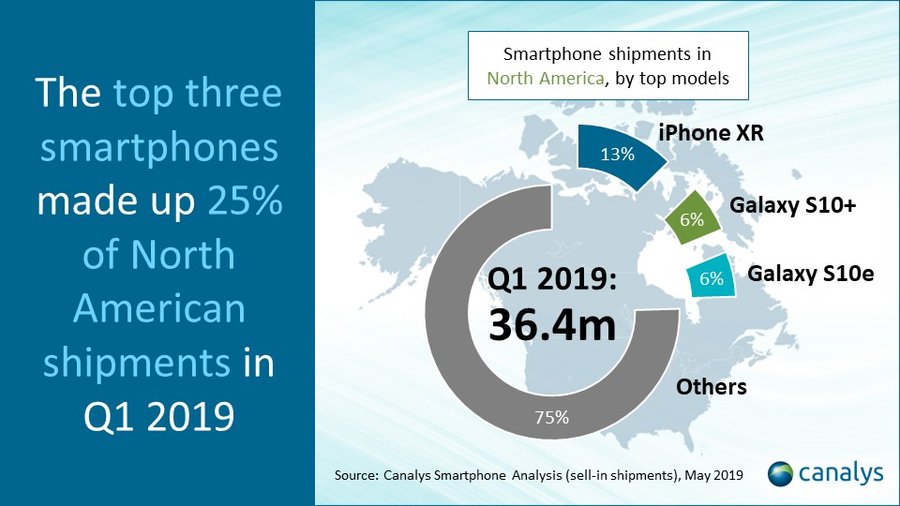Canalys: North American smartphone market plunges to five-year low but Samsung rallies with Galaxy S10
Palo Alto, Shanghai, Singapore and Reading (UK) – Thursday, 9 May 2019
Smartphone shipments in North America plummeted 18% year on year in Q1 2019 to a five-year low of 36.4 million units, down from a record high of 44.4 million in Q1 2018.This is the steepest fall ever recorded, due to a lackluster performance by Apple and the absence of ZTE. But Apple remained the clear leader, despite suffering a regional decline of 19%. It shipped more than 4.5 million iPhone XR handsets in the quarter, while Samsung shipped more than 2.0 million each of its Galaxy S10+ and S10e models.

Samsung narrowed Apple’s lead in the first quarter, shipping 29% of North America’s smartphones, against 23% in Q1 2018. Samsung scheduled an earlier launch date for the S10 series, and more than doubled shipments over the S9 series in their respective launch quarters.
“Samsung brought real differentiation to its Galaxy S10 devices,” said Canalys Research Analyst Vincent Thielke. “Its triple camera, ultra-wide-angle lens, hole-punch display and reverse wireless charging all raised consumer interest. While these technologies are not new, Samsung is among the first to bring them to the US in a mass-market smartphone, and the appeal of such new features will be important for other launches this year. Samsung also benefited from carrier promotions in Q1, which used the Galaxy S10e as an incentive. But it will come under pressure later in 2019 as other vendors, such as OnePlus, follow suit with new features, while Google starts expanding into additional channels and price bands, and ZTE attempts to re-establish its footprint at the low end.”
Apple shipped 14.6 million iPhones in Q1 2019, down 19%, but maintained a 40% share of the North American market. It was helped by carrier and retail discounts on older models, such as the iPhone 6S and iPhone 7, as well as the growing use of trade-in promotions, but this was not enough to offset the shortfall in iPhone shipments in Q1.
“Apple’s fall in Q1 followed particularly high shipments of flagship iPhones in the previous quarter,” said Thielke. “But there was a disconnect between channel orders and consumer demand, which then caused early shipments in Q1 to be challenging for Apple. But moving into March, we did see an uptick in iPhone XR shipments, an early sign that these challenges may be starting to ease at home. Apple has shown how vital trade-ins have become by moving the mechanism to the front and center of its ordering process, and it now frequently uses the net price in its flagship iPhone marketing. The momentum of trade-in promotions in Q2 and Q3 will determine the extent to which Apple can counter negative market forces, such as longer device lifecycles. But the key challenge in coming months remains that its latest iPhones are just not different enough, though new ones are on the way. For its performance to improve in 2020, Apple will need to emphasize radical new features that are most likely to impress consumers.”

Email Newsletters
Sign up to receive TelecomTV's top news and videos, plus exclusive subscriber-only content direct to your inbox.



